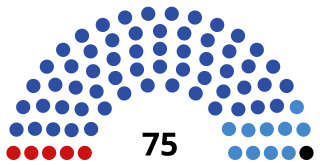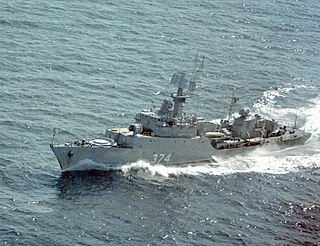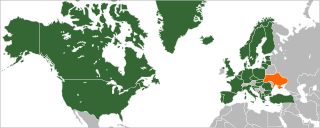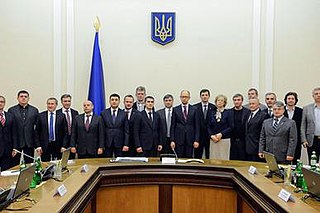The politics of Ukraine take place in a framework of a semi-presidential republic and a multi-party system. A Cabinet of Ministers exercises executive power. Legislative power is vested in Ukraine's parliament, the Verkhovna Rada.

Leonid Makarovych Kravchuk was a Ukrainian politician and the first president of Ukraine, serving from 5 December 1991 until 19 July 1994. In 1992, he signed the Lisbon Protocol, undertaking to give up Ukraine's nuclear arsenal. He was also the Chairman of the Verkhovna Rada and a People's Deputy of Ukraine serving in the Social Democratic Party of Ukraine (united) faction.

The Ukrainian Navy is the maritime forces of Ukraine and one of the five branches of the Armed Forces of Ukraine.

The State Council of Crimea is the parliament of the Russia-administered Republic of Crimea. It claims to be a continuation of the 'Supreme Council of Crimea' following a vote by the Ukrainian parliament to dissolve the Supreme Council of Crimea. The Parliament is housed in the Parliament building in the centre of Simferopol.

Lutsk (Луцьк) was an anti-submarine corvette of the Ukrainian Navy. Board number U205. In March 2014 Lutsk was captured by Russian forces during the Crimean crisis.

The Party "Soyuz" is a pro-Russian political party in Ukraine that was mostly based in Crimea until 2014. It was registered in June 1997 under a registration number 867.

There are currently no diplomatic or bilateral relations between Russia and Ukraine. The two states have been at war since Russia invaded the Crimean peninsula in February 2014, and Russian-controlled armed groups seized Donbas government buildings in May 2014. Following the Ukrainian Euromaidan in 2014, Ukraine's Crimean peninsula was occupied by unmarked Russian forces, and later illegally annexed by Russia, while pro-Russia separatists simultaneously engaged the Ukrainian military in an armed conflict for control over eastern Ukraine; these events marked the beginning of the Russo-Ukrainian War. In a major escalation of the conflict on 24 February 2022, Russia launched a large scale military invasion across a broad front, causing Ukraine to sever all formal diplomatic ties with Russia.

Relations between Ukraine and the North Atlantic Treaty Organization (NATO) started in 1991 following Ukraine's independence after the dissolution of the Soviet Union. Ukraine first joined NATO's Partnership for Peace program in 1994, later joining the Planning and Review Process in 1997 and the NATO-Ukraine Commission in 1998. Although Ukraine initially declared neutrality and non-alignment with military blocs after independence, it later signaled interest in eventual NATO membership. After Russia's annexation of Crimea and support for separatist forces in eastern Ukraine in 2014, Ukraine began actively pursuing NATO membership, formally declaring it a strategic policy objective in 2017.

Turkey and Ukraine have a long chronology of historical, geographic, and cultural contact. Diplomatic relations between both countries were established in early 1990s when Turkey became one of the first states in the world to announce officially about recognition of sovereign Ukraine. Turkey has an embassy in Kyiv and a consulate general in Odesa. Ukraine has an embassy in Ankara and a consulate general in Istanbul. Turkey is a full member of NATO and Ukraine is a candidate. Also both countries are BLACKSEAFOR and BSEC members.
The only presidential elections were contested in the Republic of Crimea for the post of President of Crimea, at the time a republic within Ukraine. The office was created by the Verkhovna Rada of Crimea, the republic's unicameral parliament October 13, 1993. Elections were subsequently held on January 16, 1994 with the second round on January 30 since a two-round system was used to elect the President. The presidential elections in Crimea were one of the most important precedents of the Crimean crisis that laid the basis for the Ukrainian-Russian international relationship.

A city with special status, formerly a "city of republican subordinance", is a type of first-level administrative division of Ukraine. Kyiv and Sevastopol are the only two such cities. Their administrative status is recognized in the Ukrainian Constitution in Chapter IX: Territorial Structure of Ukraine and they are governed in accordance with laws passed by Ukraine's parliament, the Verkhovna Rada. Most of Ukraine's 27 first-level administrative divisions are oblasts (regions).

Pavlo Valentynovych Lebedyev is a Russian and former Ukrainian politician, financier and businessman who is currently a member of the Board of Russian Union of Industrialists and Entrepreneurs (RUIE). Head of Coordination Council of the Crimean branches of RUIE.

The first government headed by Arseniy Yatsenyuk was created in Ukraine on 27 February 2014 in the aftermath of the Revolution of Dignity. The cabinet was formed as a coalition of the Batkivschyna, UDAR and Svoboda political parties, the Economic Development and Sovereign European Ukraine parliamentary factions, and a number of unaffiliated MPs. On 24 July 2014, UDAR, Svoboda and 19 independent MPs exited the coalition to pave the way for the early parliamentary elections of late October 2014. Prime Minister Yatsenyuk announced his resignation the same day, but the Verkhovna Rada declined his resignation on 31 July 2014.
The annexation of Crimea by the Russian Federation took place in the aftermath of the 2014 Ukrainian revolution. On 22–23 February, Russian President Vladimir Putin convened an all-night meeting with security services chiefs to discuss pullout of deposed President, Viktor Yanukovych, and at the end of that meeting Putin remarked that "we must start working on returning Crimea to Russia.". Russia sent in soldiers on February 27, 2014. Crimea held a referendum. According to official Russian and Crimean sources 95% voted to reunite with Russia. The legitimacy of the referendum has been questioned by the international community on both legal and procedural grounds.

The Autonomous Republic of Crimea is an administrative division of Ukraine encompassing most of Crimea that was annexed by Russia in 2014. The Autonomous Republic of Crimea occupies most of the peninsula, while the City of Sevastopol occupies the rest.

In February and March 2014, Russia invaded the Crimean Peninsula, part of Ukraine, and then annexed it. This took place in the relative power vacuum immediately following the Revolution of Dignity. It marked the beginning of the Russo-Ukrainian War.

The Republic of Crimea is a republic of Russia, comprising most of the Crimean Peninsula, but excluding Sevastopol. Its territory corresponds to the pre-2023 territory of the Autonomous Republic of Crimea, a de jure subdivision of Ukraine. Russia occupied and annexed the peninsula in 2014, although the annexation remains internationally unrecognized.
Events in the year 2021 in Ukraine.

In March and April 2021, prior to the 2022 Russian invasion of Ukraine, the Russian Armed Forces began massing thousands of personnel and military equipment near Russia's border with Ukraine and in Crimea, representing the largest mobilisation since the illegal annexation of Crimea in 2014. This precipitated an international crisis due to concerns over a potential invasion. Satellite imagery showed movements of armour, missiles, and heavy weaponry towards the border. The troops were partially withdrawn by June 2021, though the infrastructure was left in place. A second build-up began in October 2021, this time with more soldiers and with deployments on new fronts; by December over 100,000 Russian troops were massed around Ukraine on three sides, including Belarus from the north and Crimea from the south. Despite the Russian military build-ups, Russian officials from November 2021 to 20 February 2022 repeatedly denied that Russia had plans to invade Ukraine.

With the dissolution of the Soviet Union and Ukrainian independence the majority ethnic Russian Crimean peninsula was reorganized as the Republic of Crimea, after a 1991 referendum with the Crimean authorities pushing for more independence from Ukraine and closer links with Russia. In 1995 the Republic was forcibly abolished by Ukraine with the Autonomous Republic of Crimea established firmly under Ukrainian authority. There were also intermittent tensions with Russia over the Soviet Fleet, although a 1997 treaty partitioned the Soviet Black Sea Fleet allowing Russia to continue basing its fleet in Sevastopol with the lease extended in 2010. Following the impeachment of the relatively pro-Russia Ukrainian President Viktor Yanukovych, Russia invaded Crimea, overthrew the elected Autonomous government and claimed to annex it in 2014.

















